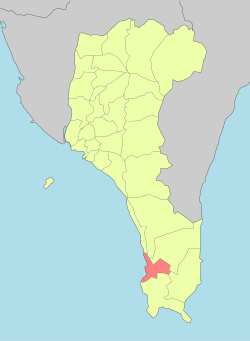Checheng, Pingtung
22°04′47″N 120°44′45″E / 22.079754°N 120.745727°E
Checheng Township
車城鄉 Chai-cheng | |
|---|---|
 | |
 Checheng Township in Pingtung County | |
| Location | Pingtung County, Taiwan |
| Area | |
• Total | 50 km2 (20 sq mi) |
| Population (February 2024) | |
• Total | 8,002 |
| • Density | 160/km2 (410/sq mi) |
| Checheng Township | |
|---|---|
| Traditional Chinese | 車城鄉 |
| Hanyu Pinyin | Chēchéng Xiāng |
| Wade–Giles | Ch'e1-ch'eng2 Hsiang1 |
| Pha̍k-fa-sṳ | Tshâ-sàng-hiông |
| Hokkien POJ | Chha-siâⁿ-hiong/Chhia-siâⁿ-hiong |

Checheng Township[1] is a rural township in Pingtung County, Taiwan.[2]
Names and etymology
The name of the town. Checheng (Chinese: 車城; pinyin: Chēchéng) combines the Chinese character for "cart", 車 today used to refer to cars and other motorized transport, and 城 which is used in words for walled fortresses and cities, but which in the Taiwanese historical context refers to a town with an earthen security berm.
With the arrival of ethnic Chinese on Taiwan, the native Paiwan name of Kabeyawan was transliterated as Ku-piah-oan (龜壁灣) in the Taiwanese Hokkien language of these new settlers.[3] Following the period of Dutch rule in the 17th century, the name Thóng-léng-po͘ (統領埔; Hakka: Thúng-liâng-phû) was used after Koxinga's son and successor Zheng Jing stationed troops there under a tongling (統領),[3] a military officer with rank roughly equal to a battalion commander; The suffix po͘ (埔) is often used for place names in Taiwan. A village gradually grew up in the area.[3]

After the Manchu Qing Dynasty assumed control of the lowlands of western Taiwan, ethnic Chinese settlers wanted protection from aboriginal attacks.[3] A wooden palisade was built around the town giving rise to a new name, Chhâ-siâⁿ (柴城; Hakka: Tshài-sàng),[3] using the character 柴 (chhâ) which is the Hokkien word for "wood". Thus Chhâ-siâⁿ has roughly the meaning of "stockade".
In 1788, the fifty-third year of the Qianlong Emperor's rule, Manchu general Fuk'anggan landed his army in the area to suppress the Lin Shuangwen rebellion.[3] In commemoration, the town received yet another name Hok-an-chng (福安庄; also Hok-an-siâⁿ [福安城]),[3] with 福 from Fuk'anggan's Chinese name and 安 for "pacified", plus 庄, meaning "hamlet".
The origin of the town's current name Checheng is disputed.[3] Some such as Japanese anthropologist Inō Kanori believe that it arose as a mispronunciation of Chhâ-siâⁿ (柴城);[3] the pronunciations of 柴 and 車 are similar in both Hokkien and Hakka, chhâ/chhia and tshài/tshâ respectively. Another theory is that as an aboriginal army approached the town, the inhabitants used dozens of oxcarts carrying charcoal to lined up as a defense.[3]
Today, Hokkien-speaking inhabitants continue to pronounce the name of the town with the older Chhâ-siâⁿ, though the written form is almost inevitably 車城. English-language maps and sources have historically used spellings such as Chasiang that reflect this pronunciation.
Geography

Area: 49.85 square kilometres (19.25 sq mi)
Population: 8,002 (February 2024)
Administrative divisions
The township comprises 11 villages: Baoli, Fuan, Fuxing, Haikou, Houwan, Puqi, Sheliao, Tianzhong, Tongpu, Wenquan and Xinjie.
Education
Tourist attractions
- Checheng Fu'an Temple
- Kenting National Park
- National Museum of Marine Biology and Aquarium
- Sichongxi Hot Spring
- Dongyuan Forest Recreation Area and Dongyuan Wet Grassland
- Shihmen Ancient battle Field and Mudan Incident Memorial Park
- Syuhai Grassland Recreation Area
- Hsi Chung River Hot Spring
- HaiKou
- Gourmet: Huang's peeled mung bean desert[permanent dead link]
Notable natives
- Pan Men-an, Magistrate of Pingtung County
References
- ^ 臺灣地區鄉鎮市區級以上行政區域名稱中英對照表 Archived 2012-03-25 at the Wayback Machine Glossary of Names for Administrative Divisions. (in Chinese) Accessed at Taiwan Geographic Names Information System website Archived 2013-08-16 at the Wayback Machine (in English). Ministry of the Interior. 16 June 2011. Retrieved 15 August 2015.
- ^ "Attractions > Hot Spots > Pingtung County > National Museum of Marine Biology and Aquarium >". Archived from the original on 2013-09-21. Retrieved 2012-11-07.
- ^ a b c d e f g h i j 《歷史沿革》 ["History"] at 屏東縣車城鄉公所官方網站 [Checheng Township Government website]. Archived 2014-02-20 at the Wayback Machine.
External links
- Checheng Township Office, Pingtung County Government (in Chinese)
- Checheng Township Travel Guide (in English)
